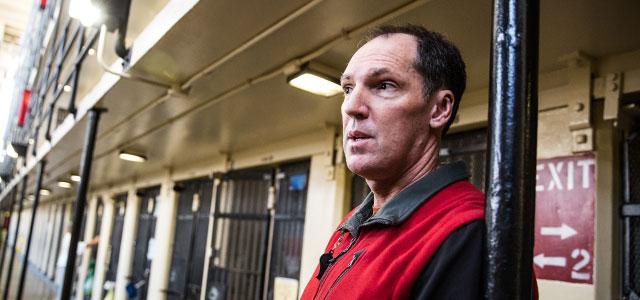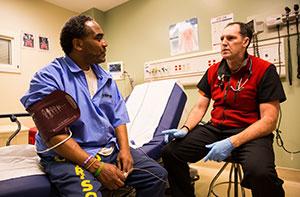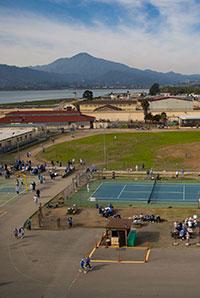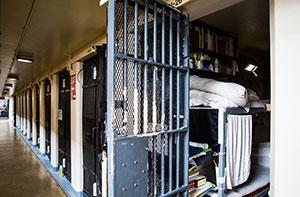
Douglas Long at San Quentin State Prison (photos by Elisabeth Fall)
Nursing in Prison
For Douglas Long, San Quentin State Prison has never been the forbidden prison fortress of American crime lore.
The 164-year-old facility, with its castlelike ramparts, death row and famous inmates, was where his mother worked as a secretary for 15 years. Long grew up nearby in Marin County and today lives five minutes away in a 1939 bungalow built by a man who was in charge of the prison’s accounting.
Since 2013, Long – a doctoral student at UC San Francisco School of Nursing – has also been working at San Quentin as a registered nurse, assigned to the Triage and Treatment Area (TTA) in the new, state-of-the art Central Health Services Center. There he provides emergency and urgent care to San Quentin’s 3,800 inmates.
Not the Inmates of Movies and News Reports
At age 50, Long projects a sense of the ordinary while providing nursing care in this extraordinary setting.
Some of his unflappability has to do with his personal history; he became a nurse after serving in the US Army, working in business, monitoring elections for the United Nations, competing in triathlons and climbing mountains around the world.
But it’s also true that Long’s workplace looks just like an emergency room at any community hospital and that many of his patients rarely act like scary individuals, despite years of harsh prison living, says Long. For one thing, many are older, in their 40s and above.
“People expect prisons, from movies and TV, to have a bunch of young tough guys ready to start a fight,” says Long. “The fact is some prisons are starting to resemble senior citizens’ homes.”
As Long’s UCSF colleague Brie Williams, an associate professor in the School of Medicine’s Division of Geriatrics, has documented, the rapidly increasing population of older prisoners – most commonly defined as those 50 and older or 55 and older – presents state and federal correctional systems with serious challenges. Older inmates constitute about 10 percent of the inmate population, and their numbers have jumped 79 percent between 2000 and 2009. Long is a member and Williams is director of the University of California’s Criminal Justice and Health Consortium, a collaborative effort of experts from across the UC system to bring evidence-based solutions to prison health care.
While prisons have a constitutional obligation to provide adequate health care, it’s not easy, particularly with older inmates. Williams has noted that many facilities aren’t prepared to handle older prisoners’ unique needs. Their medical care costs an estimated four to nine times more than that of younger inmates, and many of these older adults suffer from a litany of chronic medical conditions, ranging from diabetes, heart failure, end-stage liver disease and infectious diseases through dementia, lack of mobility and hearing loss.
Long encounters these challenges every day. For his dissertation, he will explore how prison life affects aging with his advisor, Dean David Vlahov, whose career in public health included 10 years as a clinical nurse and two years nursing in a prison unit.
San Quentin inmates won’t be part of Long’s study, but his regular contact with them has raised questions he hopes to investigate, especially this one: Does the emotional and physical stress of confinement accelerate the onset of age-related illnesses, or are these conditions the result of pre-incarceration hard living?
“It’s a tough nut to crack,” Long says. “In a lot of cases, now that they are in prison, they finally have access to health care, food and housing. [Perhaps] the only reason they are still alive is that they got arrested.”
Changing Times for Prison Health Care
Long’s correctional career is happening at a time that’s historically transformative for US prisons. Mass incarceration, especially of men of color, has become a topic of national concern.
In 1980, prison population in the US was roughly 500,000; by 2008, it was as high as 2.3 million. Severe overcrowding in California prisons became the backdrop to a 2001 federal class-action lawsuit, which alleged that the dire state of medical care in California prisons violated the Eighth Amendment of the US constitution, which forbids cruel and unusual punishment. This eventually led, in 2005, to a federal judge placing California’s prison health care system under the control of a federal receivership.
At San Quentin, a 2006 report prepared on behalf of the California Department of Corrections and Rehabilitation found “organizational chaos” in the prison’s medical services, which were spread among eight clinics. For example, the clinic serving the South Block was cramped and cluttered, sanitation was poor, and sick inmates went unseen for days or received poor follow-up care.
A Renovated Health Center
 Douglas Long treats a patient in the Triage and Treatment Area in the prison's new, state-of-the art Central Health Services Center. Ultimately, in response to the many concerns, San Quentin’s health care facilities underwent major renovations, including the opening of a new $142 million, five-story Central Health Services Center. Fronted by the brick façade of the original 1885 hospital, the center covers a one-acre site above the “dungeon,” the prison’s original subterranean cellblock, built in 1850.
Douglas Long treats a patient in the Triage and Treatment Area in the prison's new, state-of-the art Central Health Services Center. Ultimately, in response to the many concerns, San Quentin’s health care facilities underwent major renovations, including the opening of a new $142 million, five-story Central Health Services Center. Fronted by the brick façade of the original 1885 hospital, the center covers a one-acre site above the “dungeon,” the prison’s original subterranean cellblock, built in 1850.
In addition to the TTA, the new center houses an extensive array of services: dental, mental health, inpatient care and specialty care. A 2013 report found that “significant improvements” had been made to how San Quentin delivers health care.
The TTA, for example, has four clean, bright patient stations and westward-facing windows that offer a commanding view of the hills of Marin County, but the prison setting is still apparent in how a correctional officer stands duty at the nurse’s station, and heavy steel doors open into two rooms, holding cagelike “therapeutic modules.” When high-security inmates need a private consultation with a staff member, the inmates stay locked in the modules.
While Long says security always remains a foremost concern, he adds that correctional officers play an important, though unheralded, role in providing good health care. “We health professionals rely on the officers to know these inmates, their behaviors and needs, because they are with the inmates all day long,” he says. “Good officers are invaluable for spotting guys with unmet needs, medical or mental health.”
The windows of the TTA also look down on the recreation yard, where blue-clad inmates enjoy time outside their cells to exercise or mingle. At one point, on a Tuesday morning, Long and his colleagues rushed to the window to see that officers had commanded inmates to sit on the ground. Long said it was hard to tell what had happened, but he was watching to see if someone was hurt.
 San Quentin Prison's yard with the Marin County hills in the background No one was, but “Things can turn in a heartbeat,” he says. If someone were hurt, the guards would call “man down,” and one of the nurses would grab an emergency bag and jump on a golf cart outfitted with a red-cross sign. “We have four minutes to be at the person’s side. Those are the standards.”
San Quentin Prison's yard with the Marin County hills in the background No one was, but “Things can turn in a heartbeat,” he says. If someone were hurt, the guards would call “man down,” and one of the nurses would grab an emergency bag and jump on a golf cart outfitted with a red-cross sign. “We have four minutes to be at the person’s side. Those are the standards.”
Midlife Career Change
Though he seems at home in his role, until a decade ago Long never considered a career in health care. He graduated from UC Berkeley at age 19, served four years in the Army and then gravitated toward business, working as a pricing analyst for a Hong Kong-based shipping company, getting an MBA degree and lecturing at San Francisco State University on transportation and logistics.
Yet in his late 30s, when it became clear his shipping industry job would be outsourced overseas, Long decided he wanted a “rewarding” job that would get him outside a cubicle. He went through the police academy in Marin County, but then some nurses opened his eyes to how nursing could allow him to pursue a career that fit many of his interests. “There are so many different types of nursing,” he says.
He earned his BSN degree at Samuel Merritt University in Oakland and worked in emergency departments at Kaiser medical centers before learning how prison nursing would allow him to work in everything from urgent care to psychiatric nursing. “You operate almost like a nurse practitioner,” he says. “You’re able to make independent assessments.”
After working at California State Prison, Solano, he was delighted to get a job closer to home at San Quentin, where he’s worked in many different areas, including the new 40-bed psychiatric unit for death row inmates.
Facilitating a Therapeutic Environment
Long says he’s not privy to an inmate’s criminal history, but he may assume that an inmate from a certain housing area is a gang member or sex offender, and he can’t help but recognize the names of certain death row inmates whose crimes have been well publicized. For security and treatment reasons, officers may also inform him that a certain inmate coming into the TTA was the aggressor in a fight.
Still, none of this information affects the care he delivers. “I always address them as Mr. So-and-So,” he says. “You just follow the same basic, commonsense rules of respect. That’s what a nurse does.” By and large, Long gets that respect back.
That may be as much due to his approach as it is to the fact that many of the inmates he encounters have learned the best way to get through prison is to obey the rules and get along. In fact, to be housed in San Quentin’s general population, inmates must meet a medium-security level, and most are going through programs with the hope of rehabilitation, said Sgt. Christopher Siino, assistant to Warden Ron Davis. In California’s 36-facility prison system, San Quentin is actually a highly desirable place, especially for inmates from Northern California. Its location makes it easy for families to visit, and its fame makes it a magnet for thousands of volunteers, who help augment a large roster of yoga, poetry, education, self-help and vocational classes.
The older inmate cohort is another reason for the generally calm environment. On a recent Tuesday morning, the only sounds coming from the 700 or so medium-security inmates in North Block consisted of the soft hum of conversation from a group playing a board game, or barely perceptible TV dialogue.
But in North Block, with its five tiers of 4-by-9-foot cells, the challenges of San Quentin’s aging population become clear.
The metal bunks are difficult for anyone with bad backs or knees. Long and other nurses often hear complaints about back issues – some genuine, some exaggerated.
 North Block cells Inmates who have medical or mobility issues tend to get a cell on the first or second level. Signs hang on the bars of some cells, indicating, “This inmate has mobility issues.”
North Block cells Inmates who have medical or mobility issues tend to get a cell on the first or second level. Signs hang on the bars of some cells, indicating, “This inmate has mobility issues.”
Those with chronic illnesses like heart disease, high cholesterol or diabetes face other challenges. Tobacco and alcohol – two common impediments to a healthy lifestyle – are less of a problem here than on the outside, since San Quentin inmates aren’t officially allowed to smoke and shouldn’t have access to alcohol. There is an underground marketplace, but access to these substances is irregular at best.
Another challenge, Long says, is that it’s not realistic to tell an inmate to take up a certain exercise program or to eat fewer processed foods, especially if his three meals a day come from the processed-food-rich choices available in the cafeteria.
“You always want to empower patients and teach them how to manage their own health,” says Long. “But the reality hits that you’re talking to a guy who will spend 12 hours a day in a cell, so you have to figure out how to make this work.”
Still, he and his colleagues do their best to empower inmates with care and information to look after their health. After all, he argues, keeping these inmates as healthy as possible isn’t just a legal requirement and a moral imperative; it can also affect the general public’s health, as the vast majority of inmates will one day leave prison and return to society.
“A prison nurse can do a lot more than just take care of a person’s health,” Long says. “The nurse in a prison can give these patients control over their own health, which will go a long way towards helping them control their lives when they are living in the community.”



